|
|
|
Sort Order |
|
|
|
Items / Page
|
|
|
|
|
|
|
| Srl | Item |
| 1 |
ID:
086999


|
|
|
|
|
| Publication |
2009.
|
| Summary/Abstract |
In February 1998, Osama Bin Laden published a signed statement calling for a fatwa against the United States for its having 'declared war against God'. As we now know, the fatwa resulted in the unprecedented attack of 9/11. The issue of whether or not 9/11 was in any way predictable culminated in the public debate between Richard Clarke, former CIA Director George Tenet and the White House. This paper examines whether there was any evidence of a structural change in the terrorism data at or after February 1998 but prior to June 2001, controlling for the possibility of other breaks in earlier periods. In doing so, we use the standard Bai-Perron procedure and our sequential importance sampling (SIS) Markov Chain Monte Carlo (MCMC) method for identifying an unknown number of breaks at unknown dates. We conclude that sophisticated statistical time-series analysis would not have predicted 9/11.
|
|
|
|
|
|
|
|
|
|
|
|
|
|
|
|
| 2 |
ID:
097502


|
|
|
|
|
| Publication |
2010.
|
| Summary/Abstract |
This short communication examines whether or not U.S. natural gas consumption follows a stationary process. Unlike previous research that has focused on regional country or industrial sector-based panel studies, this study undertakes a sub-national investigation of natural gas consumption for the 50 U.S. states. Levin et al. (2002), Im et al. (2003), Maddala and Wu (1999), and Hadri (2000) panel unit root and stationarity tests reveal that natural gas consumption is integrated of order one. However, once allowance is made for endogenously determined structural breaks, the Carrion-i-Silvestre et al. (2005), Im et al. (2005), and Westerlund (2005) panel unit root and stationarity tests indicate that natural gas consumption is integrated of order zero. Discussion of the structural breaks is briefly surveyed in relation to the natural gas industry's response to legislative actions.
|
|
|
|
|
|
|
|
|
|
|
|
|
|
|
|
| 3 |
ID:
180163
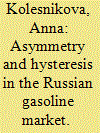

|
|
|
|
|
| Summary/Abstract |
Using monthly data of 79 Russian regions from 2003 to 2017, we study the long-run relationship of the retail gasoline prices with the crude oil price and the nominal exchange rate. We find that models that were successfully applied to deal with asymmetries in other countries are not suitable for Russia without taking structural breaks into account. Once breaks are allowed, we find that there is no asymmetry in the long-run elasticities between the gasoline prices and the crude oil price, and no significant hysteresis. However, there is an asymmetric relation between the gasoline price and the exchange rate that has decreased over time. These results also hold after several robustness checks. The evidence reported in this work shows that the effects of the exchange rate on gasoline prices are much more difficult to control than the oil price, and they require a larger set of policy measures: the recent development of a plan to decrease the importance of hydrocarbons exports by producing clean hydrogen using electrolysis and pyrolysis and the potential future export of electricity generated using nuclear power and onshore wind farms may help to diversify the local economy and to shield it from new sanctions.
|
|
|
|
|
|
|
|
|
|
|
|
|
|
|
|
| 4 |
ID:
094385
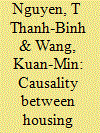

|
|
|
|
|
| Publication |
2010.
|
| Summary/Abstract |
This paper investigates the housing-macroeconomic nexus in Taiwan with endogenous structural breaks during 1991-2006. GDP and CPI are taken into consideration for examining the inflation hedging ability of Taiwan's housing returns and the contribution of the housing market to economic growth. The empirical results show that the growth of GDP actually affects inflation, but it does not cause the growth in housing returns. In particular, when taking the time trend into account, it is found that the effect of inflation on housing returns is negative and the effect of housing returns on inflation is positive. This evidence demonstrates the ineffectiveness of inflation hedging of Taiwan's housing during the period of study and the opportunistic characteristic of investors. In addition, the growth of the housing market is not beneficial for economic growth in the long-run, yet it leads to higher inflation in the short-run.
|
|
|
|
|
|
|
|
|
|
|
|
|
|
|
|
| 5 |
ID:
050402


|
|
|
| 6 |
ID:
187361
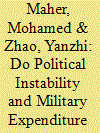

|
|
|
|
|
| Summary/Abstract |
Previous studies have investigated the relationship between political instability and economic growth separately from the relationship between military expenditure and economic growth. Besides, they did not cover the period after 2011 (i.e. the Arab Spring and its consequences). Therefore, this paper attempts to empirically analyze the long-run and short-run impacts of both political instability and military expenditure on economic growth in Egypt. We estimate the autoregressive distributed lag (ARDL) approach using data on the Egyptian economy over the period 1982–2018. For the robustness of our results, we use the fully modified ordinary least squares (FMOLS) estimator. Results of the ARDL approach indicate a significant negative relationship between political instability and economic growth in both the long-run and short-run. Contrarily, military expenditure has an insignificant impact on economic growth, especially in the long-run. These results are confirmed by the FMOLS estimator. Moreover, the estimated coefficient on the one-period lagged error correction term (ECTt-1) indicates that deviations from the long-run equilibrium relationship are corrected within a year.
|
|
|
|
|
|
|
|
|
|
|
|
|
|
|
|
| 7 |
ID:
121748


|
|
|
|
|
| Publication |
2013.
|
| Summary/Abstract |
This study reinvestigates the effect of defence spending on economic growth using Zivot and Andrews and Lee and Strazicich, structural unit root tests and the autoregressive distributed lag bounds testing approach to cointegration in augmented version of Keynesian model for India. Study confirmed long run relationship among variables studied show that economic growth is positively affected by defence spending (also negative impact after a threshold point), investment and trade openness while negatively by interest rate. Granger causality analysis revealed bidirectional causal relationship between defence spending and economic growth as probed by variance decomposition approach.
|
|
|
|
|
|
|
|
|
|
|
|
|
|
|
|
| 8 |
ID:
163533
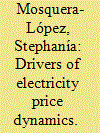

|
|
|
|
|
| Summary/Abstract |
Against the backdrop of numerous evidence that variable renewable generation decreases electricity prices and increases price volatility, this paper assesses the drivers of electricity prices in spot and futures markets, focusing on the German electricity markets. We take into account nonlinearities in electricity prices by means of structural breaks and threshold regressions. We find that short-run and medium/long-run price drivers differ and, more importantly, that they vary over time. In the case of the spot market, the determinants of prices are renewable infeed and electricity demand, while in the futures market the main drivers are natural gas, coal and carbon prices. Our results give relevant insights for market participants who seek to optimize procurement/selling strategies in the spot market, and use the futures market to hedge against spot price volatility, which has increased due to a higher renewable generation.
|
|
|
|
|
|
|
|
|
|
|
|
|
|
|
|
| 9 |
ID:
151196


|
|
|
|
|
| Summary/Abstract |
This study reexamines the sustainability of the current account in Nigeria over four decades using time-series analysis on annual data from 1981 to 2013. We focus on two analytical distinctions to the inter-temporal budget constraint (IBC) hypothesis in relation to previous studies. First, we extend the standard bivariate approach to a multivariate framework that accounts for the roles of oil price variations and financial deepening, which have important implications for resource allocation. Second is the use of the Toda–Yamamoto modified Wald (MWALD)-based causality test that is also carried out to arbitrage between the results with and without a structural break. It employs both the conventional unit root test (augmented Dickey–Fuller [ADF] and Phillips–Perron [PP]) and the unit root test with a structural break (Perron, 2006; Zivot & Andrews, 1992). It also carries out the conventional residual-based cointegration test (Engle & Granger, 1987) and the residual-based cointegration test with a structural break (Gregory & Hansen, 1995). Findings suggest that there is current account sustainability in Nigeria and structural changes were not very potent during the period under consideration. This implies that the Nigerian economy complied with the IBC hypothesis, suggesting that exports could actually finance imports.
|
|
|
|
|
|
|
|
|
|
|
|
|
|
|
|
| 10 |
ID:
147333
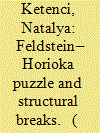

|
|
|
|
|
| Summary/Abstract |
The purpose of this article is to investigate the level of capital mobility in the largest economies of Asia by testing the Feldstein–Horioka puzzle. Panel estimations using quarterly data for the period from 1995 to 2011 have been made for the seven largest economies of Asia, specifically Russia, Japan, South Korea, Turkey, India, Indonesia and China. This group of countries has gained significant economic power in the world over the last decade. Specifically, the growth rates of the sample has for a long period of time exceeded the growth rates of most developed countries. The total GDP adjusted for PPP is far above of the GDP of the European Union and NAFTA groups and very close to the G7 group. The article examines changes in investment savings relationships when the presence of structural shifts—where such exist—is taken into account. Recently developed panel techniques are employed to examine the investment–savings relationship and estimate saving–retention coefficients. As a result of these estimations, countries were divided into two groups consisting of stable and unstable economies. This division of countries allows for more precise estimates of capital mobility. The empirical findings reveal the existence of the moderate level of capital mobility in the group. Results indicate that countries with relatively higher capital mobility are exposed to the negative effects of international market fluctuations.
|
|
|
|
|
|
|
|
|
|
|
|
|
|
|
|
| 11 |
ID:
116062
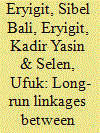

|
|
|
|
|
| Publication |
2012.
|
| Summary/Abstract |
In this study, we empirically investigate the long-run relationships between education-health expenditures, defence expenditures and economic growth in Turkey by using annual time-series data for the time period 1950-2005. To estimate these relationships, we use the cointegration method, which allows for the existence of structural breaks. The results show that there are two cointegrating vectors in the system with statistically significant structural breaks. According to the identified long-run equations, education and health expenditures affect economic growth positively, while defence expenditures have negative effects. In addition, the results show that there is a budgetary trade-off between education-health and defence expenditures.
|
|
|
|
|
|
|
|
|
|
|
|
|
|
|
|
| 12 |
ID:
117267
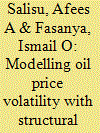

|
|
|
|
|
| Publication |
2013.
|
| Summary/Abstract |
In this paper, we provide two main innovations: (i) we analyze oil prices of two prominent markets namely West Texas Intermediate (WTI) and Brent using the two recently developed tests by Narayan and Popp (2010) and Liu and Narayan, 2010 both of which allow for two structural breaks in the data series; and (ii) the latter method is modified to include both symmetric and asymmetric volatility models. We identify two structural breaks that occur in 1990 and 2008 which coincidentally correspond to the Iraqi/Kuwait conflict and the global financial crisis, respectively. We find evidence of persistence and leverage effects in the oil price volatility. While further extensions can be pursued, the consideration of asymmetric effects as well as structural breaks should not be jettisoned when modelling oil price volatility.
|
|
|
|
|
|
|
|
|
|
|
|
|
|
|
|
| 13 |
ID:
178629
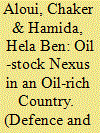

|
|
|
|
|
| Summary/Abstract |
In this paper, we attempt to delineate the relevance of geopolitical risk in the oil-stock nexus in a time-frequency domain. We resort to various wavelet coherence methods to capture the influence of geopolitical risk on the dynamic association between oil and stock prices in Saudi Arabia as a rich oil-exporting country in a region with high geopolitical risk. We primarily show that the role of geopolitical risk in the oil-stock interplay varies through timescales and investment horizons. News regarding geopolitical tensions affects the stock market in high frequency bands, while oil impacts are manifested more on longer time-horizons. Geopolitical risk weakens oil-stock connectedness in the short term. Interestingly, geopolitical incidents significantly lower the oil-stock magnitude and volatility correlation. These results offer prominent insights for investors and policy makers, which may be beneficial when responding to future geopolitical tensions in terms of risk management and the identification of investment opportunities.
|
|
|
|
|
|
|
|
|
|
|
|
|
|
|
|
| 14 |
ID:
112893


|
|
|
|
|
| Publication |
2012.
|
| Summary/Abstract |
We empirically estimate the demand for gasoline in the presence of multiple shifts caused by structural breaks using monthly data from Lebanon covering the period 2000:M1-2010:M12. Consistent with most studies in the literature, our study reports that gasoline is price and income inelastic in the short-run. However, when a single and multiple breaks are introduced, the consumers' responsiveness to gasoline price and income increase. Since both price and income elasticity are sensitive to structural changes, a policy that pleads for a flat excise tax may not be optimal with respect to either the cyclical pattern of government revenues or the internalization of international environment standards.
|
|
|
|
|
|
|
|
|
|
|
|
|
|
|
|
| 15 |
ID:
091559
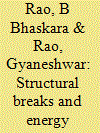

|
|
|
|
|
| Publication |
2009.
|
| Summary/Abstract |
This paper examines how energy-output ratios (EYRs) in Fiji have responded to the major energy crises and in particular if these ratios have declined after the energy shocks. The expectation is that energy efficiency should improve after an energy crisis. For this purpose we have used at first a few simpler procedures and then a recently developed more powerful tests for structural breaks by Bai and Perron [Bai, J., Perron, P., 1998. Estimating and testing linear models with multiple structural changes. Econometrica 66, 47-78; Bai, J., Perron, P., 2003a. Computation and analysis of multiple structural change models. Journal of Applied Econometrics 18, 1-22; Bai, J., Perron, P., 2003b. Critical values for multiple structural change tests. Econometrics Journal 6, 72-78]. Policy implications of our results are discussed.
|
|
|
|
|
|
|
|
|
|
|
|
|
|
|
|
| 16 |
ID:
116534


|
|
|
|
|
| Publication |
2012.
|
| Summary/Abstract |
This paper investigates the equilibrium real effective exchange rate for the Chinese RMB during the post-reform period, 1982-2010. We extend the NATREX model in several important perspectives and apply it for the first time to China. A wide range of economic fundamentals that are unique to the Chinese economy is introduced into the model. We construct a unique set of quarterly data and employ unit root and cointegration tests that can account for multiple endogenous structural breaks. In addition, to capture the evolution of China's foreign trade pattern, we employ time-varying (i.e. 3-year average) trade weights to construct the real effective exchange rate. We find two structural breaks in the cointegration relationship (in 1988 and 1992). Effective terms of trade, demographic factors, liquidity constraints and government investment are significant determinants of the equilibrium real effective exchange rate. The RMB was overvalued against a basket of 14 currencies until mid-1980s. During 1986-2010, it was undervalued in most years except after the Asian financial crisis in 1997. We have found persistent undervaluation from 2004 onwards. However, the misalignment rates are much lower than those reported by previous studies and the undervaluation rate actually declined sharply in 2008. The undervaluation rate rose modestly in 2009 and sharply in 2010, though it is still lower than what has been suggested by other studies.
|
|
|
|
|
|
|
|
|
|
|
|
|
|
|
|
| 17 |
ID:
147334


|
|
|
|
|
| Summary/Abstract |
The article analyses the behaviour of net total capital inflow and its components since the introduction of liberalisation in India in 1991. An introspective analysis of capital flow reveals that capital inflow in India is volatile in nature and it is volatile in exactly the wrong direction, in a sense that it is pro-cyclical rather than countercyclical. However, all types of flows should not be treated equally. Being the most volatile and least persistent components, FPI and commercial bank inflow should be monitored very cautiously. The volatility of foreign direct investment (FDI) and commercial borrowing has gradually increased, although it has declined recently. External assistance has declined steadily and lost its dominance relative to the other counterparts. There is ample evidence of complementarity among the components of capital flows though we get a glimpse of substitutability between FDI and FPI—the two most voluminous components of capital flows. Contrary to a-cyclical, non-debt creating flows, commercial borrowings and commercial bank flows are found to be pro-cyclical in nature. The net total capital inflow series contain three structural breakpoints, at 1995Q4, 2002Q4 and 2006Q2. Domestic growth performance, policy changes and external shocks are the key factors behind these obtained structural breaks. There was a noticeable change in the behaviour of total capital flow and its components over the four phases identified in the article.
|
|
|
|
|
|
|
|
|
|
|
|
|
|
|
|
| 18 |
ID:
127303
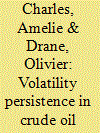

|
|
|
|
|
| Publication |
2014.
|
| Summary/Abstract |
Financial market participants and policy-makers can benefit from a better understanding of how shocks can affect volatility over time. This study assesses the impact of structural changes and outliers on volatility persistence of three crude oil markets - Brent, West Texas Intermediate (WTI) and Organization of Petroleum Exporting Countries (OPEC) - between January 2, 1985 and June 17, 2011. We identify outliers using a new semi-parametric test based on conditional heteroscedasticity models. These large shocks can be associated with particular event patterns, such as the invasion of Kuwait by Iraq, the Operation Desert Storm, the Operation Desert Fox, and the Global Financial Crisis as well as OPEC announcements on production reduction or US announcements on crude inventories. We show that outliers can bias (i) the estimates of the parameters of the equation governing volatility dynamics; (ii) the regularity and non-negativity conditions of GARCH-type models (GARCH, IGARCH, FIGARCH and HYGARCH); and (iii) the detection of structural breaks in volatility, and thus the estimation of the persistence of the volatility. Therefore, taking into account the outliers on the volatility modelling process may improve the understanding of volatility in crude oil markets.
|
|
|
|
|
|
|
|
|
|
|
|
|
|
|
|
|
|
|
|
|